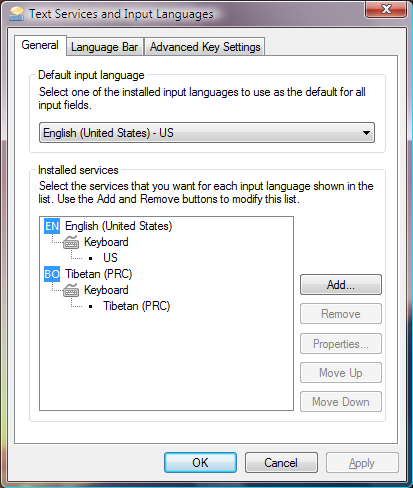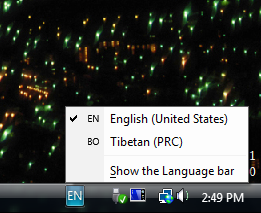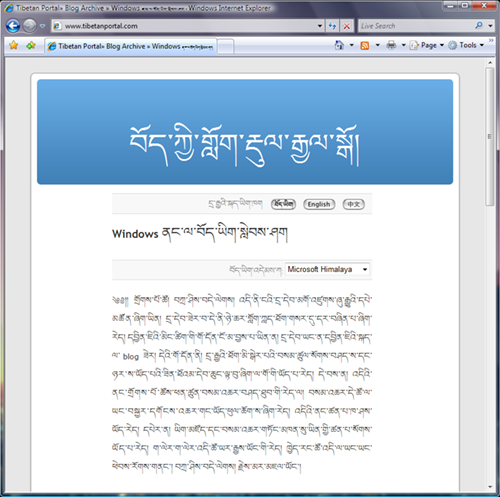THL Toolbox > Tibetan Scripts, Fonts & Related Issues > A New Chapter in Tibetan Computing
A New Chapter in Tibetan Computing
Contributor(s): Chris Walker

Figure 1: Using Notepad in Microsoft Vista
Using a computer to read and write Tibetan became much easier in January, 2007. At this time, Microsoft commenced the wide distribution of “Windows Vista” to stores and computer manufacturers. When you start using a computer with Vista, you find a Tibetan font and keyboard method already installed without the need to first download anything at all. The font is called “Microsoft Himalaya,” and the shape of the Tibetan letters are very similar to those used in books from Tibetan Publishing Houses in China. Because Microsoft is supporting Unicode, you can feel confident that the new Tibetan documents you create will be readable not only internationally, but will stay that way for a long time into the foreseeable future.
Similar to Morse code of the telegraph era, Unicode is a system of codes representing characters. In the past, when the telegraph offered the best technique for long-distance communication, messages depended on a particular series of dots and dashes to represent the Latin alphabet. When the operator receiving this extended series of dots and dashes interpreted and transcribed those codes, the finalized penmanship of that message on paper was much less important than the ''correct interpretation'' of the codes originating from the other side. An international agreement that the English letter “L”, for example, was '''dot-dash-dot-dot''' and the “P” was '''dot-dash-dash-dot''' was the crucial link in long-distance communication. People who had not memorized Morse code personally could still deliver a message to faraway friends by dictating a message to a telegraph operator. The entire system was supported by a standard of codes—what we call “encoding” today—which remained separate issue from calligraphic form the final massage when reaching the hands of the intended audience.

Figure 2: Exploring Language Options in Vista
Though the analogy isn’t perfect, the Unicode standard works in much the same way. Instead of focusing on the Latin alphabet, Unicode attempts to encompass all of the world’s languages. Tibetan is just one part of this very large chart that assigns unique digital codes to all of the various written alphabets and pictographs in the world. Tibetan, like other languages, is ultimately stored in the computer using binary circuits, where a computer must think and communicate with long series of on-or-off “bits.” Using short-hand notation, computer experts will the representation of the Tibetan character ''la'' is '''0-F-6-3''' and the character ''pa'' is '''0-F-5-4'''. It doesn’t matter what font you use to represent those codes on the screen. A little understanding of the Unicode Tibetan standard is always helpful, but you certainly don’t need a thorough comprehension to type Tibetan within Microsoft Vista. It can remain entirely invisible to you if you want, as long as you remember some of key concepts outlined below.
The Unicode Tibetan system found in Vista relies on some fairly recent improvements to the Windows system, and as such, you can not immediately use Unicode Tibetan fonts on older systems, such as Windows XP, without taking some preliminary steps. The good news is that you can potentially fix up your Windows XP computer to store and display Unicode Tibetan fairly well. The process is documented here in the Tibetan & Himalayan Library as well as on other websites, and readers who are both eager to switch to Unicode and are somewhat computer-literate may find ample assistance on the Internet.
Another key lesson to remember is that Unicode cannot be changed to accommodate older keyboard software or fonts. In reverse, existing Tibetan keyboard software and existing fonts for Tibetan should be changed to accommodate Unicode. But not to worry, a host of Tibetan computing enthusiasts are actively changing or creating new existing keyboard software or fonts to work with Unicode Tibetan. Particular fonts and keyboards will become popular in Tibet, while different ones may become active in Bhutan. But the single foundation of Unicode Tibetan will serve both these areas in very much the same way.
You are not limited to a particular font or keyboard method, though Microsoft’s built-in Tibetan functionality will be an obvious choice for many. The Microsoft Tibetan Keyboard in Vista will offer a direct way to input Tibetan Unicode characters, with one key press being equal to one Unicode Tibetan character, a single key reserved to stacking characters vertically. Others may prefer “Extended Wylie” keyboards methods, which are freely available to download off the Internet. Aside from the Microsoft Himalaya font which is immediately available in Vista, several free Unicode Tibetan fonts may be added to the computer from the Internet.

Figure 3: Activating Tibetan Keyboard Method
Most people will have older Tibetan documents using fonts that are not compatible with Unicode. Those older documents should still be readable in Vista provided you have the older fonts installed, but in light of the growing use of Unicode Tibetan you may desire to convert such documents. Given the large variety of older systems, it is impossible to say that all Tibetan documents can be converted to Unicode, but rest assured that convertors will be available to transform most of the common fonts (Sambhota, TIBBET, Tibetan Machine Web, TCRC, to name a view). By nature, the conversion programs may not be able to transform your older documents perfectly in every instance, but you will likely find them to be both fast and convenient. Most of the conversion software available was made by Tibetan computing enthusiasts, and personal communication with those developers to make improvements is always a possibility.
If anything, the arrival of Microsoft Vista should encourage the growth of Tibetan language use on the Internet. In the last year, pundits in the computer industry have been eagerly talking about the new generation of Internet services, which look and feel much more like real desktop applications. Services localized to a Tibetan language interface will include research tools, geographical maps, and online dictionaries. Perhaps earlier than this, you can expect to see more Tibetan “content management systems” localized into Tibetan, such as blogs, forums, and wikis. There are already pioneering sites which deploy older Tibetan language fonts on their sites, and many are setting their sights on Unicode in the near future.

Figure 4: Sample Blog Page Using Unicode Tibetan
In short, the release of Microsoft Vista marks an important step in the progression of Tibetan computing. It will simplify much of the current struggle to create accessible and reliable Tibetan computer tools. The gratitude we owe for this achievement should be given to the hard-working individuals, governments, academic institutions, and industries who offered scholarly opinions, technical expertise, and financial sponsorship over the last decade. The Unicode standard does not belong to Microsoft, rather it is an open standard that is gaining immediate support in other computer systems, too, such as Mac and Linux platforms. But by the mere popularity of Windows in Tibetan-speaking areas, the adoption of Unicode Tibetan in Vista will be seen as a definite benchmark in the history of Tibetan technology.